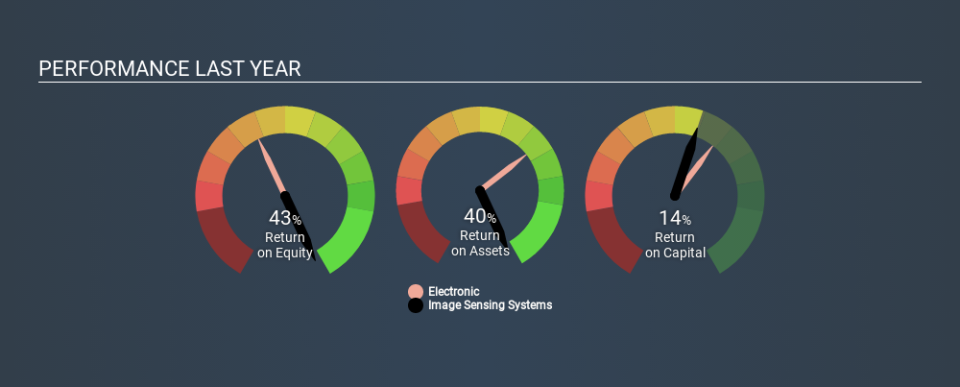Is Image Sensing Systems, Inc.’s (NASDAQ:ISNS) 14% ROCE Any Good?

Today we are going to look at Image Sensing Systems, Inc. (NASDAQ:ISNS) to see whether it might be an attractive investment prospect. To be precise, we'll consider its Return On Capital Employed (ROCE), as that will inform our view of the quality of the business.
First, we'll go over how we calculate ROCE. Next, we'll compare it to others in its industry. Then we'll determine how its current liabilities are affecting its ROCE.
What is Return On Capital Employed (ROCE)?
ROCE is a measure of a company's yearly pre-tax profit (its return), relative to the capital employed in the business. In general, businesses with a higher ROCE are usually better quality. Ultimately, it is a useful but imperfect metric. Renowned investment researcher Michael Mauboussin has suggested that a high ROCE can indicate that 'one dollar invested in the company generates value of more than one dollar'.
How Do You Calculate Return On Capital Employed?
The formula for calculating the return on capital employed is:
Return on Capital Employed = Earnings Before Interest and Tax (EBIT) ÷ (Total Assets - Current Liabilities)
Or for Image Sensing Systems:
0.14 = US$2.5m ÷ (US$19m - US$1.4m) (Based on the trailing twelve months to September 2019.)
So, Image Sensing Systems has an ROCE of 14%.
See our latest analysis for Image Sensing Systems
Is Image Sensing Systems's ROCE Good?
ROCE can be useful when making comparisons, such as between similar companies. Using our data, we find that Image Sensing Systems's ROCE is meaningfully better than the 11% average in the Electronic industry. We consider this a positive sign, because it suggests it uses capital more efficiently than similar companies. Separate from Image Sensing Systems's performance relative to its industry, its ROCE in absolute terms looks satisfactory, and it may be worth researching in more depth.
You can click on the image below to see (in greater detail) how Image Sensing Systems's past growth compares to other companies.
When considering ROCE, bear in mind that it reflects the past and does not necessarily predict the future. ROCE can be misleading for companies in cyclical industries, with returns looking impressive during the boom times, but very weak during the busts. ROCE is only a point-in-time measure. If Image Sensing Systems is cyclical, it could make sense to check out this free graph of past earnings, revenue and cash flow.
What Are Current Liabilities, And How Do They Affect Image Sensing Systems's ROCE?
Current liabilities include invoices, such as supplier payments, short-term debt, or a tax bill, that need to be paid within 12 months. The ROCE equation subtracts current liabilities from capital employed, so a company with a lot of current liabilities appears to have less capital employed, and a higher ROCE than otherwise. To counter this, investors can check if a company has high current liabilities relative to total assets.
Image Sensing Systems has total assets of US$19m and current liabilities of US$1.4m. Therefore its current liabilities are equivalent to approximately 7.3% of its total assets. In addition to low current liabilities (making a negligible impact on ROCE), Image Sensing Systems earns a sound return on capital employed.
What We Can Learn From Image Sensing Systems's ROCE
If Image Sensing Systems can continue reinvesting in its business, it could be an attractive prospect. There might be better investments than Image Sensing Systems out there, but you will have to work hard to find them . These promising businesses with rapidly growing earnings might be right up your alley.
If you like to buy stocks alongside management, then you might just love this free list of companies. (Hint: insiders have been buying them).
If you spot an error that warrants correction, please contact the editor at editorial-team@simplywallst.com. This article by Simply Wall St is general in nature. It does not constitute a recommendation to buy or sell any stock, and does not take account of your objectives, or your financial situation. Simply Wall St has no position in the stocks mentioned.
We aim to bring you long-term focused research analysis driven by fundamental data. Note that our analysis may not factor in the latest price-sensitive company announcements or qualitative material. Thank you for reading.


